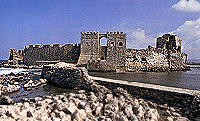 |
|
 |
Italian merchants: Trading centres
 he territorial possessions of
he territorial possessions of
 the Italians played an important role in the development of Italian trade. Here, trading activities were completely beyond the control of the Byzantine state and the privileges enjoyed by the merchants facilitated the organisation and the commercial activities of these areas. the Italians played an important role in the development of Italian trade. Here, trading activities were completely beyond the control of the Byzantine state and the privileges enjoyed by the merchants facilitated the organisation and the commercial activities of these areas.
The
Venetians established themselves in Constantinople during the first half of the 13th century, and from there they travelled to the Black Sea as well as all over Greece and the Aegean. In the Peloponnese they annexed Methone and Korone, and in the Aegean they extended their domination over Euboea and the islands. Particularly important, of course, was the conquest of Crete which, after 1261, played a leading role in Venetian trade. Venetian merchants also established themselves in Bulgaria, Armenia Minor and Cyprus.
The presence
 of the Genoese was considerable, but was confined at first mainly to Thessalonike and the Duchy of Athens. The recovery of Constantinople in 1261, although it was finally achieved without the help of the Genoese, cost the Byzantines dear, as they were obliged to cede commercial benefits and privileges as well as large tracts of land to Genoa. The port of Galata, outside Constantinople, grew rapidly both in size and in economic importance after 1267. It constituted a major Genoese centre of commercial activity, as did also Kaffa in the Crimea. After 1261, Kaffa grew into an important city and a transit centre for luxury goods, while until 1360 it also constituted a centre for the wheat trade. Another important trading centre was that of Chios. The island, a bone of contention between the rival powers, finally remained in Genoese hands, retaining its position as a major commercial centre until 1566. From the end of the 13th century on, the Genoese spread out and established themselves in many ports of the Aegean and the Black Sea, thus posing a serious threat to the Venetian merchants. of the Genoese was considerable, but was confined at first mainly to Thessalonike and the Duchy of Athens. The recovery of Constantinople in 1261, although it was finally achieved without the help of the Genoese, cost the Byzantines dear, as they were obliged to cede commercial benefits and privileges as well as large tracts of land to Genoa. The port of Galata, outside Constantinople, grew rapidly both in size and in economic importance after 1267. It constituted a major Genoese centre of commercial activity, as did also Kaffa in the Crimea. After 1261, Kaffa grew into an important city and a transit centre for luxury goods, while until 1360 it also constituted a centre for the wheat trade. Another important trading centre was that of Chios. The island, a bone of contention between the rival powers, finally remained in Genoese hands, retaining its position as a major commercial centre until 1566. From the end of the 13th century on, the Genoese spread out and established themselves in many ports of the Aegean and the Black Sea, thus posing a serious threat to the Venetian merchants.
|